Seven years after a series of accidents that placed it among the lowest-rated nuclear power stations in the country, Entergy's Arkansas Nuclear One is now officially back among the ranks of the best.

|
Then-Nuclear Regulatory Commission Chairman Stephen G. Burns visiting Arkansas Nuclear One in 2016 during an inspection.
Source: United States Nuclear Regulatory Commission (U.S.NRC)
|
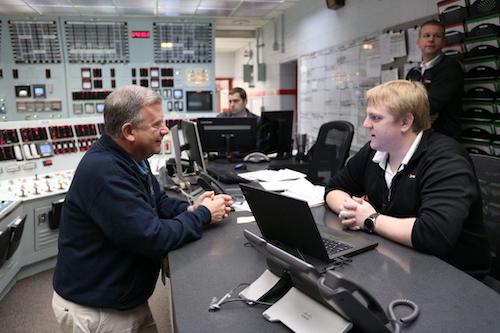
|
NRC Commissioner David Wright speaks with management while Local 647 member, reactor operator Seth Houghan (center) keeps an eye on the controls.
Source: United States Nuclear Regulatory Commission (U.S.NRC)
|
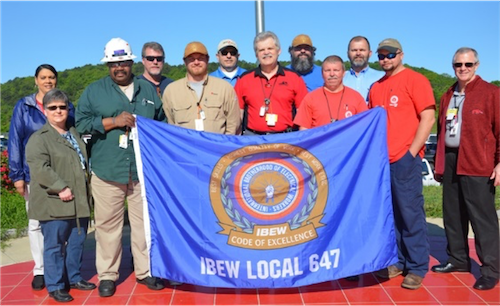
|
|
In 2017, Business Manager Shannon Walters and ANO management raised the IBEW's first Code of Excellence flag at the plant, signifying the positive changes to come.
|
At the core of that recovery was a transformation of the relationship between the facility's management, corporate executives and members of Little Rock, Ark., Local 647.
"Back in the 90s we were one of the best plants in the industry," said Local 647 Business Manager Shannon Walters. "Now, we are back where we were and always wanted to be."
This fall, the Institute of Nuclear Power Operations, a private auditing agency that evaluates the performance of nuclear power stations, gave ANO its highest rating — 1.
Only two years ago, during INPO's last biannual review, ANO was reportedly ranked near the bottom, a 3 out of 4. INPO ratings are not made public.
And INPO was not alone.
ANO was in the Nuclear Regulatory Council's basement too. Where INPO focuses on operations and performance, NRC ranks plants primarily on compliance with safety and security regulations, and ANO was severely underperforming.
Since a crane collapse and a transformer fire in 2013, ANO was in NRC's Column 4. The only other plant rated so low, Pilgrim in Massachusetts, shut down. Column 5 designation is the precursor to being forcibly shut down.
"The threat that ANO would close was real," said Utility Department International Representative Mark MacNichol, the senior nuclear expert in the IBEW. "ANO had to turn it around or it had no future."
Since 2013, at least 10 nuclear power stations have been shuttered, some for maintenance and mechanical reasons. But economic pressure has been rising on nuclear power as fracking sent gas prices plummeting and no carbon price had been put in place to reward nuclear's clean, consistent, carbon-free power generation.
Starting with Kewaunee in Wisconsin, seven of the 10 nuclear closures were economic. It has sent shockwaves through the industry, which once claimed nuclear power was too cheap to meter.
ANO and the 900 direct jobs and thousands of secondary jobs that the plant supports were in the balance.
The Decision to Change
Before he became the senior director for engineering and risk at the Nuclear Energy Institute and an inspector for INPO, Steve Geier himself worked at a troubled power station, Nine Mile Point in New York, which, at one point in his career, was rated the lowest with a 4.
To explain the difference between an INPO 1 and INPO 4 plant, Geier used the example of an isolation/lockout tag that was put on the wrong relay.
"An INPO 1 plant would catch a wrong tag in the self-check phase, early, early on and it is extremely rare," he said. "At an INPO 4 maybe they did the tag and they also had the wrong boundary. Maybe multiple times. It wouldn't get caught until farther down so someone may have been at risk. Fundamentally though, the issue is that the plant culture can't seem to get a handle on how to get the performance up."
In 2013, the year Walters took over as business manager, a crane collapsed during an outage as the company was replacing a 525-ton stator, the component that transforms DC to AC power. A 24-year-old contract iron worker was killed when it fell, and it did extensive damage to the facility as it fell into the train bay. At least eight other people were injured.
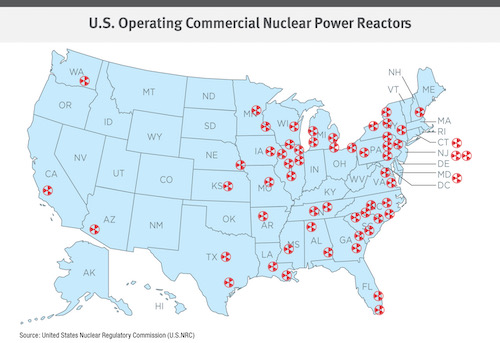
|
|
U.S. Operating Commercial Nuclear Power Reactors Source: United States Nuclear Regulatory Commission (U.S.NRC)
|
A few months later, one of the main transformers exploded, leaving a black scorch mark more than 100 feet high on the outside of the turbine building. The transformer had been scheduled to be replaced with a new one in 2009, and even though the new component was purchased and delivered to the site, the transformer replacement was postponed until the old device finally failed. No one was injured in that accident.
"At that time, communication was broken. Management ignored us," Walters said. "When we went into Column 4, the site vice president seldom communicated with us and our input was often ignored. We are professionals in the IBEW. We should be listened to."
But, Walters said, the professional opinions on maintenance and repair weren't acted on.
"We take pride in our work and are committed not just to being good, but being the best," he said. "It absolutely pained our members to see the state of the plant."
The NRC and INPO ratings plummeted, but they were only making plain what could no longer be ignored.
"Culture and behaviors manifest themselves in overall performance and quality on the job," Geier said. "NRC ratings are about compliance and they do those inspections regularly."
But coming back from a low INPO rating is, in his words, "more of a journey."
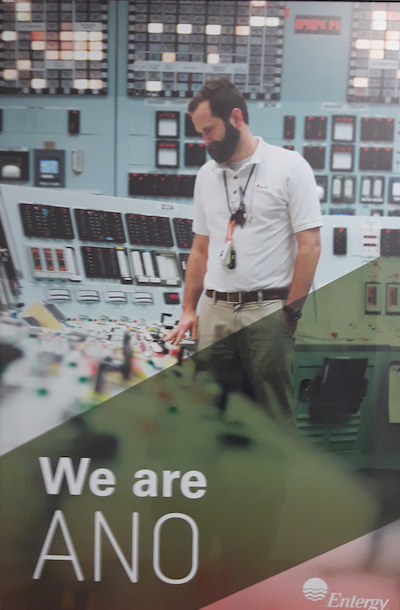
|
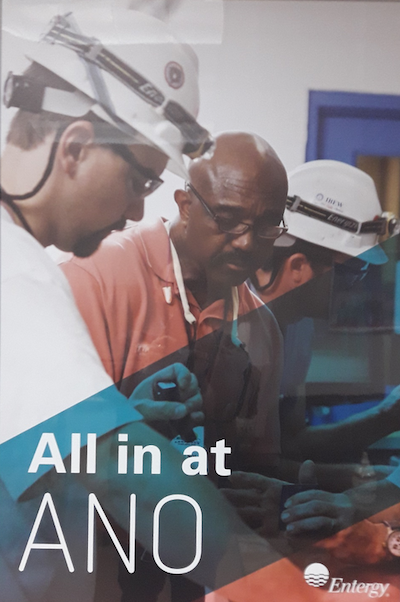
|
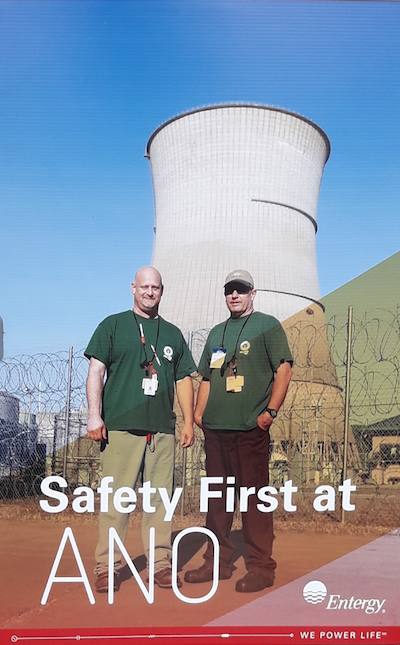
|
|
As part of the effort to turn Arkansas Nuclear One around, plant-owners Entergy adopted many of the ideas of the Code of
Excellence and prominently featured Little Rock, Ark., Local 647 members, often wearing IBEW clothing, in campaigns
posted around the plant.
|
New policies are just "new paint," Geier said, and the industry experts sent in by INPO, including himself, are looking not for quick answers, but deep transformations in every corner of the plant.
"It has to be embraced all the way through the organization. Every employee has to be on board. It can't be because management is watching over you with punitive measures in place. We want to see that they are doing it because it is the culture. That is expected," Geier said.
And everyone knew the stakes. While some nuclear facilities have closed after years of protests and political pressure, Walters said ANO is seen differently in northwest Arkansas.
"People would march in the streets to keep us open. You close ANO, it would devastate three counties," Walters said.
The Code of Excellence
The first step, Geier said, is not policy in most cases; it is personnel. And that change did happen at ANO. Local 647 adopted the Code of Excellence, then Entergy sent in a new leadership team.
Walters said they were ready and willing to listen and cooperate with the IBEW.
"The new site VP, Rich Anderson, was smart enough to reach out to us and say, 'We need your help,'" he said. "And the timing was a godsend because we were prepared."
Walters said they began COE trainings at the local's fossil and hydro plants starting in the spring of 2016. Trainings at ANO began in October and by the end of the month, the trainings had expanded to the whole plant, bringing in not just IBEW members but non-bargaining, other trades and even nonunion workers.
"There was a straightforward message: 'All of us must do our best to get this place back on track,'" Walters said.
In each training session, Walters said he asked a key question: "What is the main thing the company wants to do?"
"I always got the same response: 'make money; be productive and work safely,'" he said. "Then I would ask them what the main thing you, the worker, want. I would hear those same three answers again: 'make money, be productive and be safe.'"
Those common interests were enough to build on.
"When managers and non-bargaining employees came to our COE training and heard our message of a deep and personal commitment to safety, professionalism, accountability, relationships and quality, they sat up in their chairs and realized, 'These guys are doing something to help us,'" Walters said. "Even before policies were changed, minds and hearts were."
In 2017, the chief steward, Randy Flippo, and Walters were invited to an offsite leadership retreat. Walters said there was tension in the room; some of the managers couldn't understand what the union was doing at their retreat.
"They looked at us like a couple of strays that had just wandered into the Westminster Dog Show," Walters said.
But that meeting started to build relationships.
At the end of the retreat, the facilitator asked what could be done when they went back to work tomorrow to show that things were changing at ANO.
"I said, 'I'll tell you what you can do: you can start by saying 'Good morning.' Because some of you won't even speak when I walk right by you at the plant, you don't even look my way," he said.
Walters knew a greeting was not the same as funding a maintenance project that had been put off, but it was a necessary start.
ANO was still NRC Column 4 and low-rated at INPO in early 2018, but there were signs of rejuvenation. The Electrical Worker first covered the early stages of the turnaround in 2017 and followed up a year later.
The company started investing in the facility to improve its performance, appearance and reliability. Leaders started inviting IBEW members to participate in discussions about training, maintenance and improvements around the facility. Then the company put up posters, banners and images featuring IBEW members and the Code's SPARQ acronym.
"When people saw that everyone was talking, listening and we were working together, it proved that things were beginning to move in the right direction and that we were being treated with respect, that seemed to put the wind in their sails," Walters said. "Because we had a workforce that was raring to go."
By design, the Code is a flexible program that allows locals to tailor the execution of the ideals to the specifics of the institution, said Education Department Director Amanda Pacheco.
"Where it has been incredibly successful, there is a structure, and everyone feels a sense of responsibility for their success. They feel ownership of it," she said.
For Tenth District International Vice President Brent Hall, the key is separating COE stewards from traditional union stewards.
"You have grievances, and you have gripes. Gripes are more dangerous. Grievances, there is a rule there, there is a process, and it comes to an end with a decision," he said. "But gripes are a morale thing. A culture thing. That person comes in the next day and every day after more unhappy."
The Code gives both sides the opportunity to crack open those gripes and solve them, but it keeps them outside the grievance process where they often don't belong.
"When you improve communication, no one loses," Hall said.
And it doesn't work by simply doing management's job for them or by diverting real grievances.
The proof of that is membership numbers at the right-to-work plant have improved throughout.
"Every time we talk, Shannon tells me we are picking up new members, more people are getting involved," Hall said. "The Code is about giving people a voice through the IBEW."
A Milestone
On November 17, Walters was notified by Entergy Chief Nuclear Officer Chris Bakken that the results from the most recent INPO inspection had been released and ANO was now back among the top performers as an INPO 1, a rating they had not had since 2006.
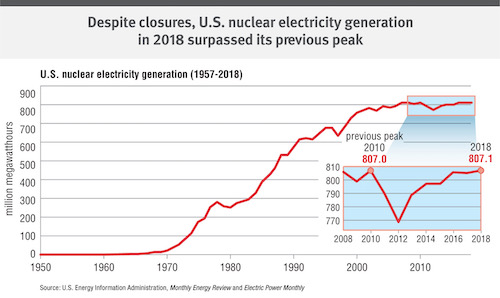
|
|
Despite closures, U.S. nuclear electricity generation in 2018 surpassed its previous peak. Source: U.S. Energy Information Administration, Monthly Energy Review and Electric Power Monthly
|
"Mr. Bakken told me no one in the industry has gone from the beginning of their NRC Column 4 recovery effort to INPO 1 in only 4 years," Walters said. "You could hear in his voice just how excited he was."
Almost as meaningful as the achievement, Walters said, was that the top executive chose to personally notify the local union when the rating came in.
"We certainly weren't shown that level of respect before we adopted the Code," he said.
It goes without saying that there are no finish lines for nuclear plants, no moment where you can sit back and rest. The expectation is perfection and nothing less for as long as the plant is alive. But it still felt like, if not victory, a moment to savor, Walters said.
"There are very few nuclear plants that reach this level of performance, and they should be very proud of how they worked with management to transform ANO into a showpiece for what the IBEW can be," said Utility Department Director Donnie Colston. And ANO is sending a message that is being heard at other utilities. INPO rating improvements can not only end conversations about closures, but they can also make plants more profitable.
"It is like a credit score. The better the number, the better insurance rates you get," MacNichol said. "Getting to INPO 1 is a big-time significant difference. The way nuclear plants are being stressed in deregulated states, the finances are very tight, and this can be huge."
One of the largest utilities and largest nuclear facility operators, the Tennessee Valley Authority, is following ANO, training everyone on their property in the Code of Excellence, MacNichol said.
"Who wouldn't want this? They changed the whole plant around in an environment where nuclear plants are under threat," he said